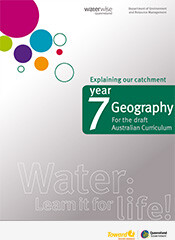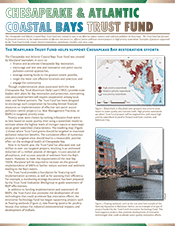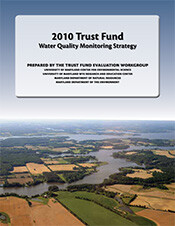Photo competition reminder
Do you have great photos from around the Bay? We want to see them! Your photo could be on the cover of the 2011 Chesapeake Bay Report Card and become the icon of 2011 Bay health. Deadline for submissions is March 15.Associated Job Vacancies
- Director, Appalachian Laboratory - UMCES seeks a dynamic leader to serve as Director of the Appalachian Laboratory (AL) at the Associate or Full Professor level.
- Director, Maryland Sea Grant College Program - UMCES is looking for a dynamic and visionary director to build on Maryland Sea Grant’s (MDSG) tradition of excellence to lead the organization into the future.
- Climate Change Communications Officer - the Secretariat of the Pacific Regional Environment Programme needs a talented science communicator to work on Climate Change Adaptation projects to develop key synthesis and communication products for multiple audiences.
Australian schools geography curriculum uses the IAN online diagram creator
 Conceptual diagrams are science communication tools that aim to communicate complex ideas about systems and processes in a simple, visual way. This education resource prepared by the Queensland Department of Environment and Resource Management, through their "Water: Learn it for Life" program, provides teachers with detailed lesson plans to take their students through the story of a river to identify the positive and negative features that most influence the health of the waterway. The lesson culminates in the students producing a conceptual diagram using the IAN Online Diagram Creator.
Conceptual diagrams are science communication tools that aim to communicate complex ideas about systems and processes in a simple, visual way. This education resource prepared by the Queensland Department of Environment and Resource Management, through their "Water: Learn it for Life" program, provides teachers with detailed lesson plans to take their students through the story of a river to identify the positive and negative features that most influence the health of the waterway. The lesson culminates in the students producing a conceptual diagram using the IAN Online Diagram Creator.
Chesapeake and Atlantic Coastal Bays Trust Fund
 The Chesapeake and Atlantic Coastal Bays Trust Fund was created in 2007 in an effort to reduce nutrient and sediment pollution to these bays. The Trust Fund has focused its financial resources on the implementation of effective non-point (i.e., diffuse) source pollution control projects in high priority watersheds. This newsletter details examples of projects supported by the Trust Fund, including stream channel restorations, stormwater retrofits, and cover crops.
The Chesapeake and Atlantic Coastal Bays Trust Fund was created in 2007 in an effort to reduce nutrient and sediment pollution to these bays. The Trust Fund has focused its financial resources on the implementation of effective non-point (i.e., diffuse) source pollution control projects in high priority watersheds. This newsletter details examples of projects supported by the Trust Fund, including stream channel restorations, stormwater retrofits, and cover crops.
2010 Trust Fund Water Quality Monitoring Strategy
 This Monitoring Strategy was designed to identify nutrient reduction efficiencies of best management practices (BMPs) and provide information to determine what type of monitoring is needed by Trust Fund recipients to evaluate the effectiveness of BMP implementation. The main objective is to provide a comprehensive protocol that serves all water quality assessment needs when monitoring urban and agricultural non-point nutrient and sediment fluxes. The methods and results of several intensively monitored case studies indicate that BMP implementation can be highly effective at reducing nutrient and sediment fluxes to receiving waters.
This Monitoring Strategy was designed to identify nutrient reduction efficiencies of best management practices (BMPs) and provide information to determine what type of monitoring is needed by Trust Fund recipients to evaluate the effectiveness of BMP implementation. The main objective is to provide a comprehensive protocol that serves all water quality assessment needs when monitoring urban and agricultural non-point nutrient and sediment fluxes. The methods and results of several intensively monitored case studies indicate that BMP implementation can be highly effective at reducing nutrient and sediment fluxes to receiving waters.
Science Communication and Translation Course
 EcoCheck partnered with NOAA's Chesapeake Bay Office and the Chesapeake Bay National Estuarine Research Reserve's Coastal Training Program to facilitate a two-day workshop on effective science communication. Determining the key messages and development of the complete climate change story was the focus of the workshop. Participants learned effective science communication techniques, including layout and design principles, making conceptual diagrams, and recording effective videos. Participants attending the workshop were from academic institutions and state and federal agencies. IAN is running its next course from May 1-3 in Cambridge, MD. See the course website for more information and registration.
EcoCheck partnered with NOAA's Chesapeake Bay Office and the Chesapeake Bay National Estuarine Research Reserve's Coastal Training Program to facilitate a two-day workshop on effective science communication. Determining the key messages and development of the complete climate change story was the focus of the workshop. Participants learned effective science communication techniques, including layout and design principles, making conceptual diagrams, and recording effective videos. Participants attending the workshop were from academic institutions and state and federal agencies. IAN is running its next course from May 1-3 in Cambridge, MD. See the course website for more information and registration.

